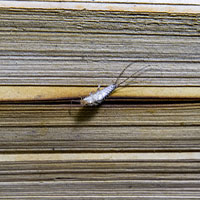Silverfish facts and info

If you've noticed small, silver insects in your home, you may be dealing with silverfish. These ancient insects are found worldwide and can be a nuisance. They are known for their destructive feeding habits and can damage your home and belongings.
Key insights
- Silverfish are nocturnal, quick-moving insects that can cause property damage.
- Silverfish are attracted to damp, humid areas and feed on items like starch, sugar, paper and glue.
- Signs of an infestation include damage to paper items or spotting yellow stains, scales or feces.
- Controlling a silverfish infestation involves reducing humidity, removing food sources and considering DIY or professional pest control.
What are silverfish?
Silverfish are small, wingless insects that are silver or gray in color and have a flattened body and a tapered tail end — they get their name from their color and fishlike appearance. Silverfish are nocturnal and move very quickly.
While silverfish aren’t harmful to humans, they can cause damage to your home and property. The pests are known for their destructive feeding habits and may ruin papers, clothing and wallpaper.
» GOT OTHER PESTS? Gnat facts and info
What attracts silverfish?
Silverfish prefer the dark and are attracted to damp, humid areas. They are most commonly found in places like the bathroom, basement or attic. These pests are particularly drawn to environments with a relative humidity level between 75% and 95%.
They are also attracted to various forms of carbohydrates and proteins that are found in starch, sugar, paper, book bindings and glue, which is why they’re often found in areas where these items are common, such as kitchens, bathrooms and basements. They are also known to consume cotton, linen and some synthetic fibers, which can damage clothing and other textiles.
You can also transport silverfish indoors unknowingly. Cardboard boxes and plastic containers recently stored in infested areas can start an infestation if you bring them inside your home.
Silverfish infestation signs
Silverfish are nocturnal and fast-moving — and they hide well, especially at night — so they can be hard to spot. However, there are some signs that can indicate their presence. These include:
- Damage to books and other paper items: Silverfish feed on carbohydrates, particularly those found in starches and dextrin in adhesives. This includes glue, book bindings, paper, photos, sugar, coffee, hair, carpet, clothing and other synthetic fibers.
- Yellow stains, scales or feces: Silverfish shed their scales and leave behind feces, which can look like tiny black specks and may be found in areas where they are feeding or hiding.
- Unusual marks on clothing or linen: Silverfish can leave behind irregular feeding marks, which can look like thin surface etchings or holes. They are particularly attracted to silk, cotton, linen and synthetic fabrics.
- Wallpaper damage: Silverfish can also eat the glue behind wallpaper, causing it to loosen or peel. If you notice unexplained wallpaper damage, it could be due to silverfish.
- Mysterious holes in cardboard boxes or food packages: Silverfish are known to chew through cardboard and thin plastic, so if you find unexplained holes in food packages or storage boxes, it could be a sign of a silverfish infestation.
How to get rid of silverfish
Getting rid of silverfish can be a challenge because of their ability to hide and reproduce quickly. However, there are several strategies that can be effective:
It’s possible to eliminate silverfish on your own, but large or persistent infestations often require hiring a professional pest control company.
Reduce the humidity
Silverfish thrive in damp, humid environments. Therefore, maintaining a dry environment is crucial in controlling them. You can achieve this by using dehumidifiers and fans to reduce the humidity in your home. Also, fixing any leaks and ensuring areas are well ventilated can help create an environment that's less attractive to silverfish.
Remove food sources
Silverfish are attracted to various forms of carbohydrates and proteins found in starch, sugar, paper, book bindings and even glue. Keeping your home clean can help reduce potential food sources. Regular vacuuming to remove food crumbs, storing food in airtight containers and keeping areas where food is stored clean can deter silverfish.
DIY pest extermination
There are several do-it-yourself pest control methods that can help control a silverfish infestation. These include using commercially available insecticides specifically designed for silverfish and setting up traps. However, it's important to follow the instructions on the product label to ensure safe and effective use.
Professional pest control
If the infestation is large or difficult to control, a professional pest control service may be needed. Professionals use a variety of methods to get rid of silverfish, including insecticides and dusts.
» DISCOVER: Best pest control companies
FAQ
Can silverfish infestations spread disease?
No, silverfish do not spread disease. However, their scales and feces can trigger allergic reactions in some people.
How quickly can a silverfish infestation spread?
Silverfish reproduce quickly and can infest a home rapidly if conditions are favorable. They prefer damp, humid environments and abundant food sources.
Can silverfish survive in all climates?
Silverfish are resilient and can adapt to various climates. However, they thrive in damp, humid environments.
Are there any natural predators of silverfish?
Yes, several insects, such as spiders, earwigs and centipedes, are known to prey on silverfish.
Can silverfish damage electronics?
While it’s not common, silverfish can potentially damage electronics if they get inside and chew on internal components.
You’re signed up
We’ll start sending you the news you need delivered straight to you. We value your privacy. Unsubscribe easily.